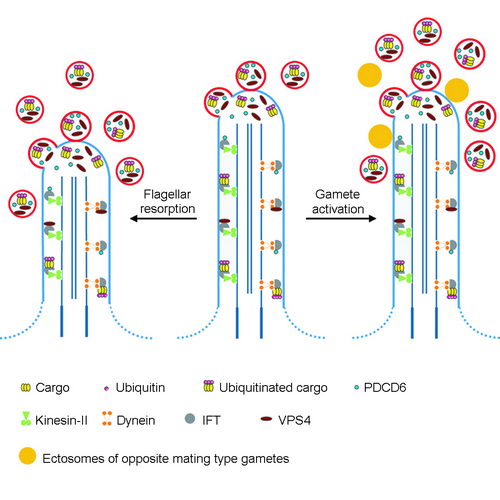
Newsroom
Formation and Functions of Ectosomes Released from Cilia/Flagella
Cilia are evolutionarily conserved organelles extending from surfaces of almost all eukaryotic cells, function in cell motility, sensory and signal transduction. Dysfunction of Cilia has been implicated in a wide spectrum of human diseases and disorders collectively known as ciliopathies. Recent work with the green alga Chlamydomonas and the nematode C.elegans demonstrated that cilia have “secretion” function. Ectosomes (one type of vesicles) can be released from the cilium, and can mediate the intercellular communication. However, the detailed mechanisms of ectosome released from cilia/flagella, as well as additional possible functions of ciliary ectosome, are currently unknown.
Scientists from Institute of Hydrobiology, Chinese Academy of Sciences (IHB) and Yale University, took advantage of the classic ciliary/flagellar research model, Chlamydomonas, to address the above issues. The cell body of Chlamydomonas is covered with a cell wall and the flagella provide the only membrane surface contacting the environment and capable of releasing membrane into the environment, thereby facilitating the purification of flagellar ectosomes.
Long et al. isolated the flagellar ectosomes and compared their protein composition with the flagellar membrane, and demonstrated that ectosomes released from the flagella have a unique protein composition, especially being enriched in small GTPases, kinases, phosphatases, endosomal sorting complex required for transport (ESCRT) and ubiquitinated proteins.
These data suggest that ectosome formation involves the active accumulation of specific proteins for release into the medium. In addition, membrane proteins have distinct distribution in ectosome and flagellar membrane, implying that there is a sorting mechanism for flagellar membrane proteins targeted to ectosomes.
ESCRT is involved in biogenesis of multivesicular bodies, viral budding, and cytokinesis and so on. They identified three ESCRT-related proteins enriched in flagellar ectosomes. Live imaging showed that an ESCRT-related protein (PDCD6) enriched ectosomes was released from the flagella during gamete activation. Knockdown of two ESCRT-related proteins, PDCD6 and VPS4, attenuated ectosome release during flagellar shortening and the shortening was slowed. These data suggested that the ESCRT proteins mediate ectosomal release and thereby influence flagellar disassembly in Chlamydomonas. This work was published in Current Biology.
In summary, their work demonstrated that ectosomes released from flagella/cilia possess a unique protein composition and participate in flagellar shortening process. The presence of ESCRT complexes and the ubiquitination pathway in flagella and flagellar ectosomes suggest they mediate the formation of the ciliary/flagellar ectosomes. These findings shed new insights on trafficking of ciliary membrane and can provide new strategies for manipulating the signaling pathways in cilia/flagella.

The secretion of flagellar ectosomes increased during flagellar resorption and gamete activation (Image by IHB)